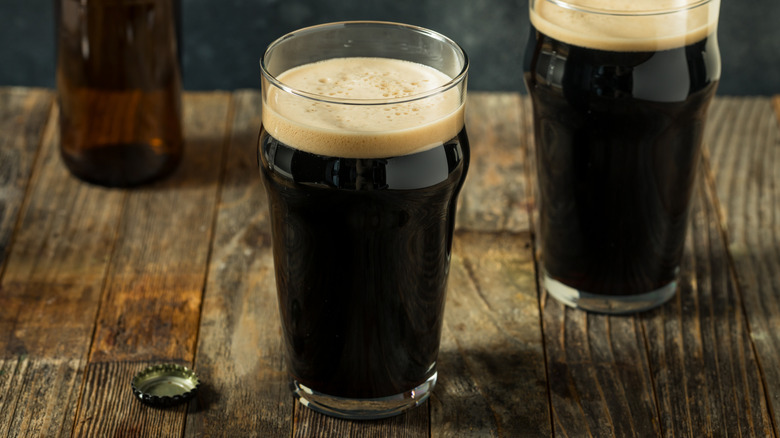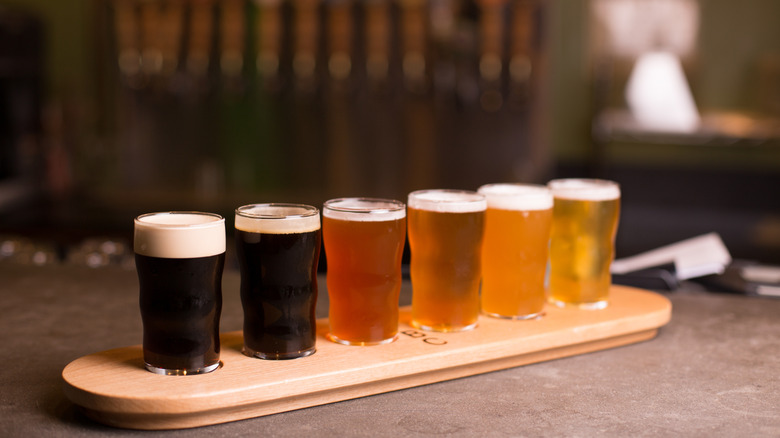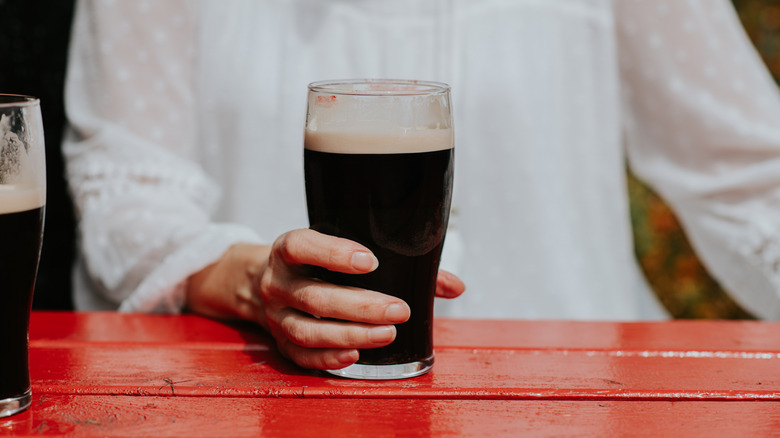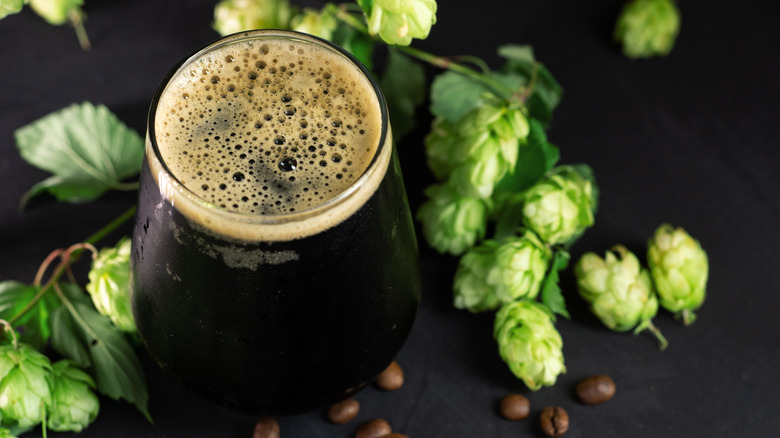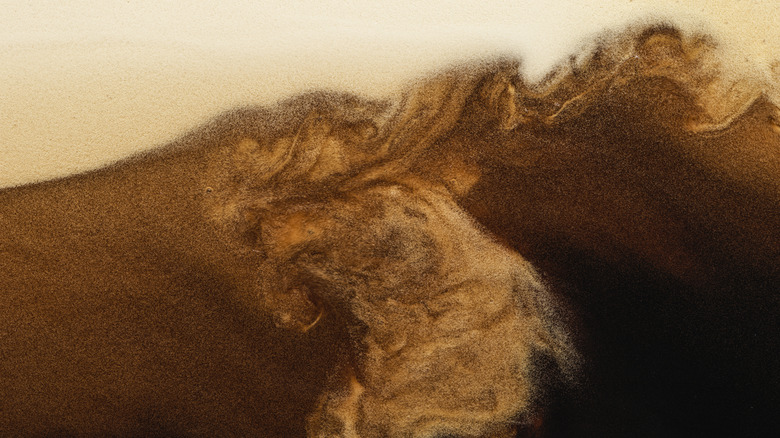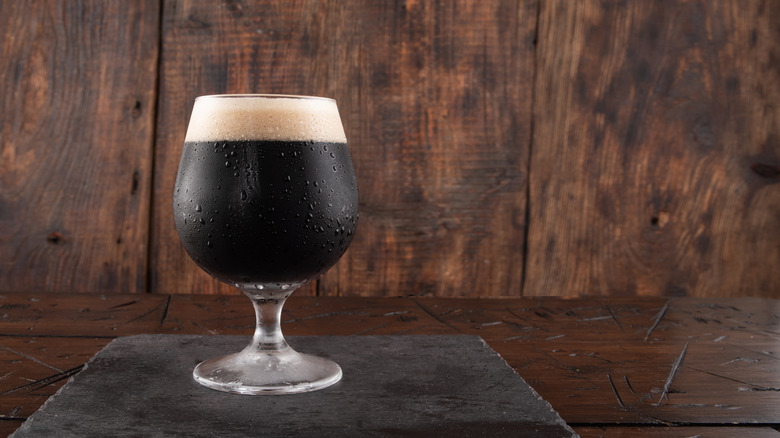Stout Vs Imperial Stout: What's The Difference Between These Beers?
We may receive a commission on purchases made from links.
If stout is the king of dark beers, then imperial stout is the emperor. Stronger than dark ales and lagers, stout beer is characterized by its deep brown or black color and roasted, chocolatey flavors. An imperial stout, on the other hand, boasts a stronger flavor and higher alcohol content. Essentially, an imperial stout is an amplified, intensified version of a stout, while stouts can be considered a broader category of beer that includes many different varieties. Both beers fall into the extensive ale category, which includes other beers like pale ales, wheat beers, and IPAs. What defines these beers is the yeast that is used: saccharomyces cerevisiae.
Stouts and imperial stouts contain the same base ingredients as other beers — a combination of water, grain, hops, and yeast — so, what exactly makes a stout so dark? This is due to the roasted barley or roasted malt that is added during the brewing process, and provides a deeper color; lighter beers typically contain unroasted grain.
The color and flavor range of stouts
With stouts and imperial stouts, the first thing you'll notice is the color. Amber, pale tan, and translucent yellow are hues we're used to seeing in a brew, but an inky black stout is sure to catch the eye. Stouts can range from a deep reddish brown color to black, and imperial stouts tend to be the darkest.
The colors of brown and black are reminiscent of chocolate and coffee, and you'll find these flavors in many stouts. However, the possible flavor notes are quite broad for this dark beer, and you might taste flavors like nuts, toast, marshmallows, malt, dried fruit, spices, licorice, vanilla, smoke, and even leather. Some stouts have more pronounced hoppy notes, depending on the style. Imperial stouts, due to their longer brewing process, can have a more intense, aged flavor, almost reminiscent of wine. Stouts can be both sweet or dry, while others are bitter, and will often be labeled as such.
Stouts: A beer with English origins
If your mind goes to Ireland when sipping on a creamy stout — know that this association is indeed accurate. The umbrella category of stouts includes a few distinct styles, American, English, and Irish.
Irish stouts tend to fall a bit more on the dryer side, with roasted and toasted flavors and a lower alcohol percentage. Guinness is the best-known example, and the most popular stout in the world is the company's Guinness Draught, which clocks in at a relatively low 4.2%. English style is very similar to Irish style, but it can include more hops and a higher alcohol percentage. American-style includes the most hops, which brings on more bitterness in the beer — in Irish stouts, the hops tend to not be very noticeable and are overpowered by other tasting notes.
Stouts may most closely associated with Ireland, but have origins in England. The beer was derived from the once popular porter in the 1700s — the main difference between stouts and porters is the barley and strength of the beer; porters use malted barley, while stouts use unmalted, roasted barley. Porters are essentially a lighter stout, and when the desire for a more robust flavor and stronger alcohol percentage arose in 18th-century England, the stout was born.
Imperial stout: a beer for the royal Russian court
If you've ever seen an imperial stout labeled as a "Russian imperial stout," that is actually the drink's full name. This is where it gets a little confusing: the imperial stout is not actually from Russia, it also emerged from England like the original stout mentioned above. It was brewed in England with the intention of exporting it to the Baltic Sea countries where a stronger flavor and alcohol content was preferred in the colder weather. "Russian" was attached to the title because it was particularly popular with the royal Russian court of Czarina Catherine the Great. The stronger ABV and extra addition of hops also played the role of preserving the beer when barrels of it were shipped across the sea.
Although a Russian imperial stout is the original of the strong, aged stout, an American imperial stout also exists. While Russian imperial stouts have a more classic, straight-forward flavor, the American version often plays around with the flavors — it's common to have the addition of ingredients like vanilla, chocolate, coffee, or to even be barrel-aged. Both styles are brewed longer than the average stout, typically falling between 8-12% ABV.
Overall, imperial stouts tend to be one of the darkest, strongest beers on the market. They often come at a higher price tag, too — the long brewing time, aging process, and the addition of specialty ingredients add to the cost.
Flavor variations to stouts
Outside of the American or Irish stouts, and Russian or American imperial stouts, there are more variations categorized by their flavor and additional specialty ingredients. The base remains the same, but new ingredients are added during the brewing process to infuse specific flavorings. These flavorings and extra ingredients don't define whether a beer is an imperial stout or regular stout — both beers can take on a new flavor a remain in their category, which as you read earlier, if defined by the strength of the beer and length of time that is was brewed for.
Two creamy styles of stouts are milk stouts and oatmeal stouts — milk stouts are brewed with lactose, while oats are added for oatmeal stouts. Pastry stouts often include the addition of sweet ingredients and added flavorings — ice cream, candied nuts, candy cane — whatever sweet treat you can dream of. If that's not enough, confuse your taste buds with a bewildering flavor combination: an oyster stout. Yes, this beer receives the addition of oyster shells during the brewing process for a touch of salt that enhances sweet notes.
For a boozy twist, stouts can also be aged in barrels that were previously used to store whiskey, brandy, or rum; wine or sherry is also sometimes used. This does two things: First, the beer starts to take on tasting notes of whatever was stored in the barrel previously. Depending on the length of the aging, it can also increase the alcohol content.
Drinking stouts and imperial stouts
Both styles of stouts are considered to be hearty beers, best drank in cooler weather or in front of a fireplace, perfect for the holiday season. A standard stout with a lower percentage is more "sessionable" than imperial stouts. Due to the higher percentage of alcohol and stronger flavor, imperial stouts are better reserved for later in the day — for the really strong imperials, some can clock up to 14%, so caution is recommended when drinking one or more. Both types of stouts are often served up in goblets, such as these.
The deep flavors of both styles of stouts make for interesting flavor pairings, both sweet and savory. Salty snacks — such as peanuts and pretzels — are the perfect companion for dry Irish stouts. Grilled meats, crispy mushrooms, burgers, and sharp cheddar are other savory flavors that work well alongside the dark beer. This pairing might be surprising, but oysters can be served with a creamier stout for a slightly sweet, briny flavor combo.
Stouts with the label of "pastry stout" or "dessert stout" naturally make for a great beverage to serve after dinner alongside a sweet treat — these will be sweeter, with flavors ranging from s'mores to peppermint. Don't forget — you can actually incorporate stout beer into desserts, too. Try an ice cream float with a base of the dark beer, or use it to bake a decadent chocolate cake.
